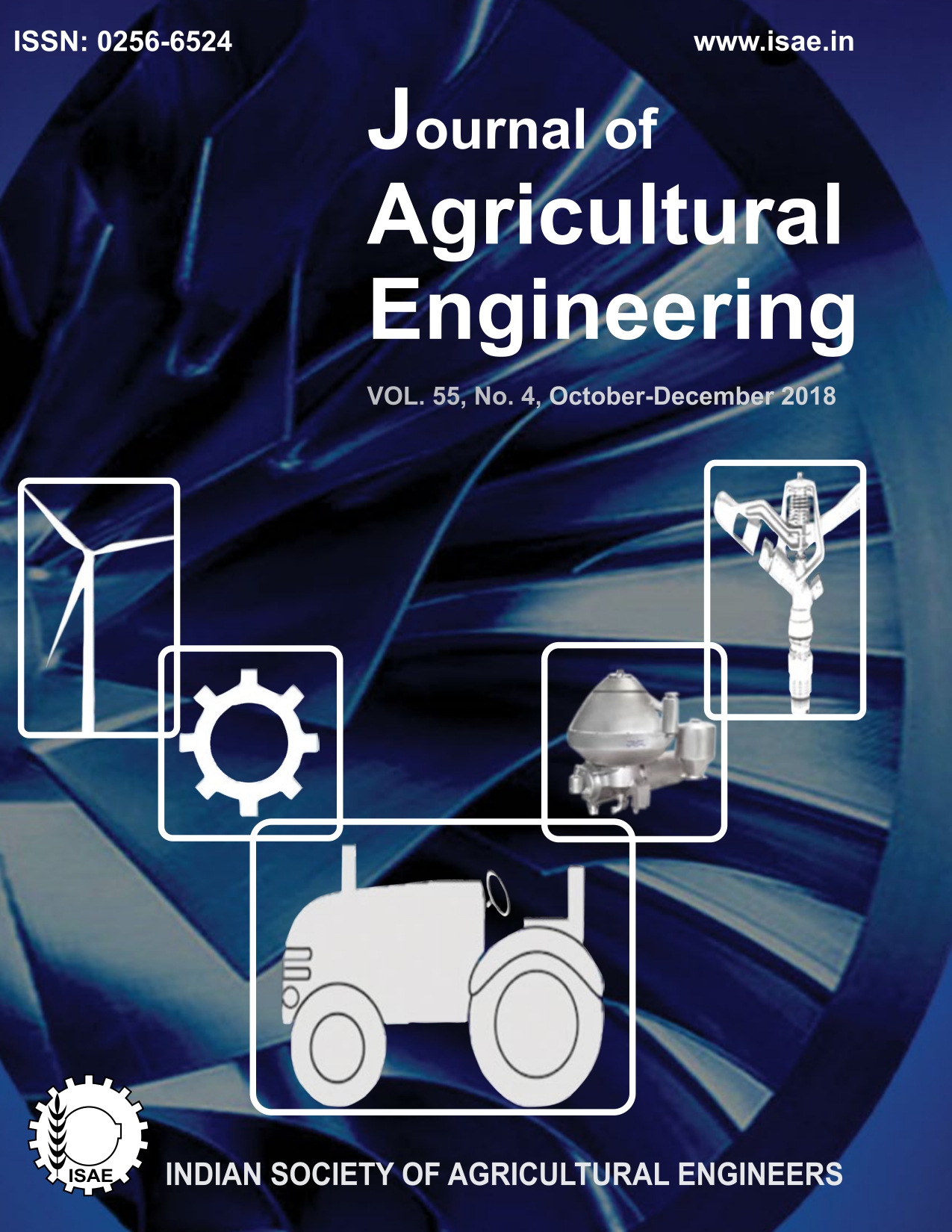Effect of Hydrothermal Treatment and Milling Parameters on Milling and Nutritional Qualities of Finger Millet (Eleusine coracana)
DOI:
https://doi.org/10.52151/jae2018554.1667Keywords:
Finger millet, hydrothermal treatment, modelling, nutrition, pearlingAbstract
The conditions for degree of pearling of finger millets were optimised based on its quality attributes. Empirical models were developed to predict quality parameters for different sets of milling conditions of dispersed density (430 kg.m-3, 495 kg.m-3, 560 kg.m-3), residence time (10 min, 12 min, 14 min) and roller speed (1000 rpm, 1200 rpm, 1400 rpm) for both untreated and hydrothermally treated finger millet. It was found that hydrothermal treatment could improve pearling efficiency and reduce anti-nutrients while retaining nutritional components to some extent. A model correlating the effect of degree of pearling with pearling efficiency, protein, tannin and calcium content of hydrothermally treated finger millets was also developed with a satisfactory level of accuracy (R2 = 0.997). This equation served to determine the required degree of pearling for any given set of milling conditions. At optimized quality parameters, the degree of pearling for finger millet was 7.4 per cent.
References
Balasubramanian S; Viswanathan R. 2010. Influence of moisture content on physical properties of minor millets. J. Food Sci. Technol., 47, 279–284.
Barbeau W E; Hilu K. 1993. Protein, calcium, iron, and amino acid content of selected wild and domesticated cultivars of finger millet. Plant Foods Human Nutr., 43, 97-104.
Bello M O; Loubes M A; Aguerre R J; Tolaba M P. 2015. Hydrothermal treatment of rough rice: effect of processing conditions on product attributes. J. Food Sci. Technol., 52, 5156-5163.
Box G E P; Behnken D W. 1960. Some new three level designs for the study of quantitative variables. Technometrics, 2, 455-475.
Chandel G; Meena R K; Dubey M; Kumar M. 2014. Nutritional properties of minor millets: neglected cereals with potentials to combat malnutrition. Curr. Sci., 107, 1109-1111.
Chandra D; Chandra S; Pallavi; Sharma A K. 2016. Review of finger millet (Eleusine coracana (L.) Gaertn): A power house of health benefiting nutrients. Food Sci. Hum. Wellness, 5, 149-155.
Devi P B; Vijayabharathi R; Sathyabama S; Malleshi N G; Priyadarsini V B. 2011. Health benefits of finger millet (Eleusine coracana L.) polyphenols and dietary fiber: A review. J. Food Sci. Technol., 51, 1021-1040.
Dharmaraj U; Malleshi N G. 2011. Changes in carbohydrates, proteins and lipids of finger millet after hydrothermal processing. LWT - Food Sci. Technol., 44, 1636-1642.
Falmata A S; Modu S; Zainab M A; Bintu B P; Yagana S. 2013. The soaking and de-hulling effects on chemical composition, tannin and mineral elements content of five local varieties of sorghum. Sch. J. Agric. Sci., 3, 126-131.
Gupta N; Srivastava A K; Pandey V N. 2012. Biodiversity and nutraceutical quality of some Indian millets. In: Proc. National Academy of Sciences, Ind. Sec. B: Biol. Sci., 82, 265-273.
Khamgaonkar S G; Singh A; Chand K; Shahi N C; Lohani U C. 2013. Processing technologies of Uttarakhand for lesser known crops: An overview. J.Acad. Ind. Res., 1, 447-452.
Lohani U C; Pandey J P; Shahi N C. 2012. Effect of degree of polishing on milling characteristics and proximity compositions of barnyard millet (Echinochloa frumentacea). Food Bioprocess Technol., 5, 1113-1119.
Lorenz K; Dilsaver W. 1980. Proso millets. Milling characteristics, proximate compositions, nutritive value of flours. Cereal Chem., 57, 16-20.
Lowry O H; Rosebrough N J; Farr A L; Randall R J. 1951. Protein measurement with the Folin phenol reagent. J. Biol. Chem., 193, 265-275.
Mangaraj S; Singh K P. 2011. Optimization of machine parameters for milling of pigeon pea using RSM. Food Bioprocess Technol., 4, 762-769.
Pomory C M. 2008. Color development time of the Lowry protein assay. Anal. Biochem., 378, 216-217.
Sade F O. 2009. Proximate, antinutritional factors and functional properties of processed pearl millet (Pennisetumglaucum). J. Food Technol., 7, 92-97.
Saleh A S M; Zhang Q; Chen J; Shen Q. 2013. Millet grains: nutritional quality, processing and potential health benefits. Compr. Rev. Food Sci. Food Saf., 12, 281-295.
Shobana S; Krishnaswamy K; Sudha V; Malleshi N G; Anjana R M; Palaniappan L; Mohan V. 2013. Finger millet (Ragi, Eleusine coracana L.): A review of its nutritional properties, processing, and plausible health benefits. Adv. Food Nutr. Res., 69, 1-39.
Singh A. 1992. Effect of degree of polish on rice bran oil and protein content of milled rice. Unpublished M.Tech. Thesis, G. B. Pant University of Agriculture and Technology, Uttarakhand, India.
Singh E; Sarita. 2016. Potential functional implications of finger millet (Eleusine coracana L.) in nutritional benefits, processing, health and diseases: A review. Int J. Home Sci., 2, 151-155.
Singh P; Raghuvanshi R S. 2012. Finger millet for food and nutritional security. Afr. J. Food Sci., 6, 77-84.
Sokra A M; Ahmad I A M; Babikar E E. 2012. Effect of germination on antinutritional factors, total, and extractable minerals of high and low phytate corn (Zea mays L.) genotypes. J. Saudi Soc. Agric. Sci., 11, 123-128.
Sripriya G; Usha A; Chandra T S. 1997. Changes in carbohydrate, free aminoacids, organic acids, phytate and HCl extractability of minerals during germination and fermentation of finger millet (Eleusine coracana). Food Chem., 58, 345-350.
Truswell A S. 2002. Cereal grain and coronary heart disease. Eur. J. Clin. Nutr., 56,1–4.
Ushakumari S R. 2009. Technological and physicochemical characteristics of hydrothermally treated finger millet. Unpublished Ph.D. Thesis, University of Mysore, Mysore, India.
Verma S S; Singh A; Shahi N C. 2014. Response surface methodology for selection of machine parameters for enhancing pearling efficiency of finger millet dehuller-cum-pearler. Int. J. Sci. Res., 3, 1469- 1472.














